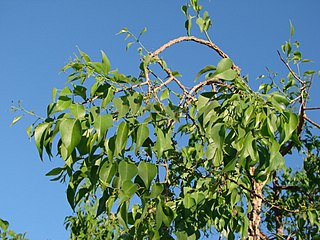
George Bentham was an English botanist, described by the weed botanist Duane Isely as "the premier systematic botanist of the nineteenth century". Born into a distinguished family, he initially studied law, but had a fascination with botany from an early age, which he soon pursued, becoming president of the Linnaean Society in 1861, and a fellow of the Royal Society in 1862. He was the author of a number of important botanical works, particularly flora. He is best known for his taxonomic classification of plants in collaboration with Joseph Dalton Hooker, his Genera Plantarum (1862–1883). He died in London in 1884.
Dicoelia is a plant genus of the family Phyllanthaceae. It was first described as a genus in 1879. It is native to Borneo and Sumatra.
- Dicoelia beccarianaBenth. - Borneo
- Dicoelia sumatranaWelzen - Sumatra

Pogonophora is a plant genus of the family Peraceae first described as a genus in 1854. It is native to central Africa and northern South America.
- Pogonophora letouzeyiFeuillet, 1993 - Gabon, Congo
- Pogonophora schomburgkianaMiers ex Benth., 1854 - Colombia, Venezuela, Guyana, Suriname, Fr Guinea, N + E Brazil
Micrandra is a plant genus of the family Euphorbiaceae first described in 1854. It is native to South America.

Merostachys is a Neotropical genus of bamboo in the grass family. It is found in South America and Central America from Belize to Paraguay.
Melocalamus is a genus of Asian bamboos in the grass family. It is found in lowland areas of Southern China, Indochina, and the eastern part of the Indian Subcontinent.

Within the Orchidaceae, Hormidium was originally a subgenus of the genus Epidendrum, but was later raised to a full genus. It is now considered not to be distinct from the genus Prosthechea, of which it is a synonym. Most of the species of Hormidium have been transferred to Prosthechea, although others are now classified in Encyclia, Epidendrum, Homalopetalum, and Lepanthes.

Andropogon is a widespread genus of plants in the grass family, native to much of Asia, Africa, and the Americas, as well as Southern Europe and various oceanic islands.

Agonandra is a genus of plants in the family Opiliaceae described as a genus in 1862.

Pholidostachys is a genus of palms found in Central America and northwestern South America.
Chaetium is a genus of Neotropical plants in the grass family.
Cleistachne is a genus of African and Asian plants in the grass family. The only known species is Cleistachne sorghoides, native to Eastern Africa and Southeastern Africa, and parts of Asia.
Craspedorhachis is a genus of African plants in the grass family.

Achillea ageratifolia, the Balkan yarrow or Greek yarrow, is a species of flowering plant in the daisy family Asteraceae, native to Bulgaria and Greece. Growing to 20 cm (7.9 in) tall and broad, it is a compact herbaceous perennial. It is a highly variable species, with three recognized subspecies. They have erect, simple, somewhat woody based stems. The narrow grey-green foliage resembles that of a related genus Ageratum, hence the Latin specific epithet ageratifolia. The solitary, daisy-like composite flower heads are white with yellow centres and about 2–3 cm across. They appear May–July in the northern hemisphere.
Thymopsis is a genus of flowering plants in the bahia tribe within the daisy family.

Lumnitzera is an Indo-West Pacific mangrove genus in the family Combretaceae. An English common name is black mangrove. Lumnitzera, named after the German botanist, Stephan Lumnitzer (1750-1806), occurs in mangroves from East Africa to the Western Pacific, and northern Australia.
Beilschmiedia gaboonensis is an evergreen tree in the subgenus Hufelandia of the genus Beilschmiedia, in the family Lauraceae. It is native to central Africa. It is a medium-sized tree which can measure up to 30 m tall with a bole diameter of up to 60 cm. It is distributed from southern Nigeria to the Congo basin, occurring in Cameroon, Gabon and Zaïre. It is associated with marshy locations in lowland rainforest. Similarly to Beilschmiedia mannii, it is known under the trade names "kanda" and "pink kanda". The bark is used in analgesic and healing ointments.
Trachyphrynium is a monotypic genus of plants native to tropical Africa. The only recognized species is Trachyphrynium braunianum(K.Schum.) Baker, widespread from Liberia to Uganda.

Catoferia is a small genus of plants in the family Lamiaceae composed of only four different species. First described in full by George Bentham in 1876, said species are native to southern Mexico, Central America, Colombia and Peru. Amongst all four species, only Catoferia chiapensis are known to grow across a wide area, their growth recorded in southern Mexico, Guatemala, Peru and Belize. Growth of the other three variants is believed to be limited to Southern Mexico. The beginning of the genus Catoferia is thought trace back to the Cretaceous era, making it around 55 to 65 million years old.
Eremitis is a genus of bamboo plants in the grass family, that is endemic to Brazil.









